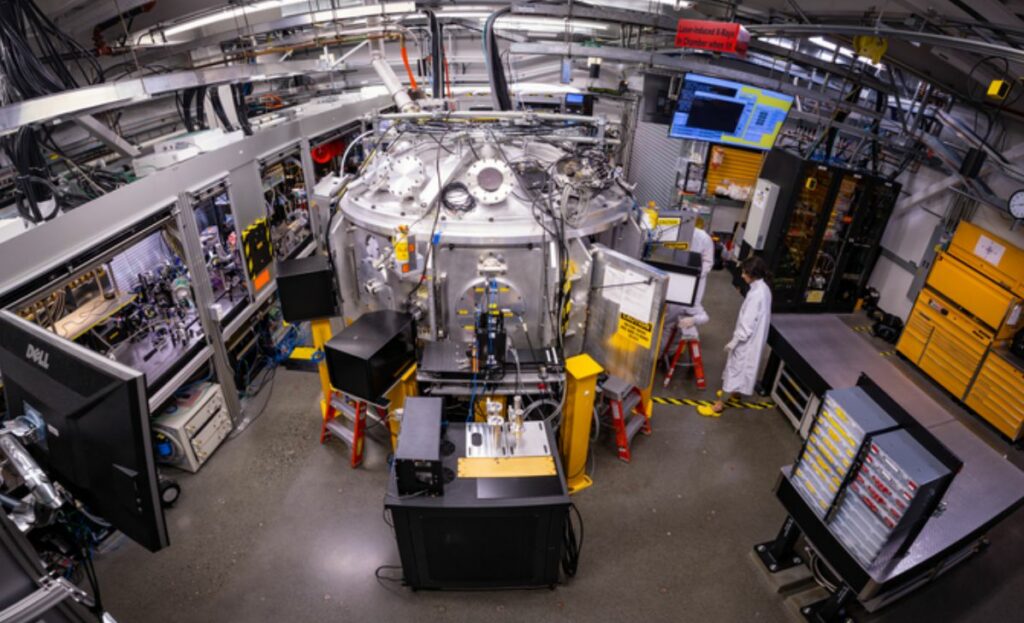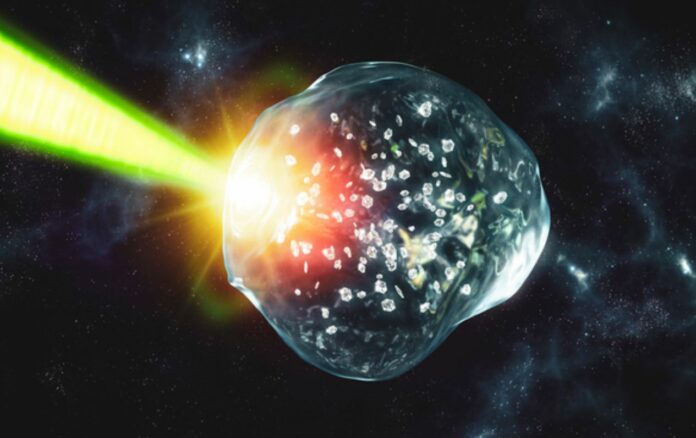What happens within planets like Neptune and Uranus? To answer this question, researchers from the University of Rostock, the Helmholtz-Zentrum Dresden-Rossendorf (HZDR), and the École Polytechnique in France designed a brand-new experiment.
They used intense laser flashes to study what happened after directing a laser onto a thin sheet of plain PET plastic. As a result, the scientists were able to support their earlier hypothesis that diamonds actually do rain inside the ice giants at the edge of our solar system.
Another advantage of this process was that it offered the possibility of developing a novel approach to making nanodiamonds, which are essential for applications such as ultrasensitive quantum sensors.
Science Advances (10.1126/sciadv.abo0617) published the group’s findings.
Extreme conditions exist inside frozen large planets like Neptune and Uranus, where pressure is millions of times greater than on Earth and temperatures can reach several thousand degrees Celsius.

However, states like these can be briefly replicated in the lab by using intense laser flashes to hit a sample of a material that resembles film, heat it to 6,000 degrees Celsius in the space of a millisecond, and create a shock wave that compresses the material to a million times the pressure of air for a few nanoseconds.
Dominik Kraus, a physicist at HZDR and professor at the University of Rostock, explains that up until this point, “we used hydrocarbon films for these kinds of studies.”
“And we discovered that this extreme pressure produced tiny diamonds, known as nanodiamonds.”
However, because ice giants also contain significant amounts of oxygen, in addition to carbon and hydrogen, it was only partially possible to replicate the interior of planets using these films.

When looking for good material for a film, the group came across PET, the resin that is used to make most plastic bottles.
According to Kraus, PET has a good balance of carbon, hydrogen, and oxygen to mimic the activities on ice planets. The group’s research was done at the SLAC National Accelerator Laboratory in California, which houses the Linac Coherent Light Source (LCLS), a potent X-ray laser powered by an accelerator.
Using two different types of measurements, they were able to determine what happens to PET film when exposed to powerful laser flashes. Small-angle scattering and X-ray diffraction were used to ascertain the growth rate and size of the diamonds.
Helpful oxygen
Dominik Kraus summarizes the findings: “The effect of the oxygen was to accelerate the splitting of the carbon and hydrogen and thus encourage the formation of nanodiamonds.” It made it easier for carbon atoms to bond and form diamonds. This lends more credence to the idea that diamonds physically fall from the sky inside ice giants. The findings likely apply to countless more planets in our galaxy in addition to Uranus and Neptune. It is now apparent that ice giant planets, once thought to be rare, are likely the most prevalent type of planet outside the solar system.
The team also found another kind of clue: when the diamonds were put together with water, they should come out in a strange way. According to Kraus, “so-called superionic water may have formed.” The hydrogen nuclei can freely roam about the oxygen atoms’ crystal lattice. Superionic water can carry electric current due to the electrically charged nuclei, which contributes to the ice giants’ magnetic field.
However, the research team’s investigations have not yet allowed them to conclusively demonstrate the presence of superionic water in the mixture with diamonds. This is anticipated to take place at the European XFEL in Hamburg, the most potent X-ray laser in the world, in close cooperation with the University of Rostock.
The international user consortium HIBEF, which is led by HZDR there, provides the best environment for experiments of this nature.
Nanodiamond factory
In addition to this rather basic knowledge, the new experiment opens the door to a technical application: the custom production of nanometer-sized diamonds, which are already used in abrasives and polishing agents.
They will be employed as powerful reaction accelerators in the future to split CO2 and serve as highly sensitive quantum sensors. In the past, Kraus says, “diamonds of this kind have mainly been produced by detonating explosives.”
They could be produced in the future considerably more neatly with the aid of laser flashes.
The scientists’ perspective A PET film is lit by a high-powered laser at ten-thousandths of second intervals, for a total of one thousand flashes per second.
The resulting nanodiamonds fly out of the film and land in a water-filled collection vessel. They can then be filtered and usefully extracted after being slowed down there.
Dominik Kraus adds that the main benefit of this technology over explosive manufacturing is that “the nanodiamonds could be custom cut with regard to size or even doping with other atoms.”
“The X-ray laser means we have a lab tool that can precisely control the diamonds’ growth.”
Image Credit: Getty
You were reading: Similar To Neptune, Study Reveals A New Path To Make Diamonds Here On Earth With Plastic
